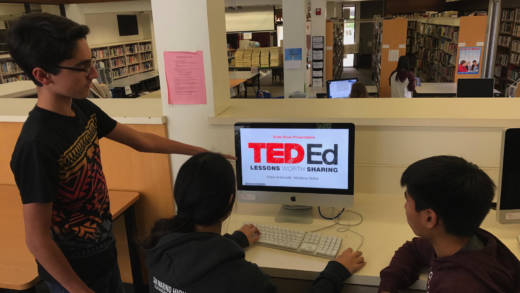At its core, a TED-Ed Lesson is a three-to five-minute animated video that focuses on topics ranging from chemistry to Shakespeare to origami, and is often created by a teacher working collaboratively with a TED-Ed scriptwriter, a professional animator and a professional voice over actor. But can a small group of high school students create a TED-Ed Lesson? And if so, could a student-produced lesson prove valuable in classrooms worldwide?
To answer the first question, I reached out over a year ago to the folks at TED-Ed and got the following response:
“Generally, we’re open to students nominating themselves for a chance to work with us on a TED-Ed Lesson. That said, a student would need to be an expert in the facts and background of the content.”
But there is a way for students to create a TED-Ed Lesson — one discovered by my world history students this past year, and which doesn’t need the help of a TED-Ed script writer, a professional animator or voiceover actor. An entirely student-produced TED-Ed Lesson. It is possible, and my students have proven it.
So what do these student-produced TED-Ed lessons look like? To find out, click on any one of the following:
- Marie Antoinette: Madame Deficit
- The Fight for the Favelas
- The Surrender of the Last Japanese World War II Soldier
- South China Sea Territorial Dispute
- Sherman’s March to the Sea
- The Attack on Benghazi
- The Armenian Genocide
- Hitler’s Mein Kampf: Again a Bestseller in Germany
The ten-step process for producing one of these lessons is described below.
Step No.1
Students form groups of two or three. (I also permit some students to work on their own.)
Step No. 2
Each group of students meets with the teacher to discuss a potential topic for the group’s TED-Ed Lesson. Only when groups have received the teacher’s permission may they move on to step
Step No. 3
Each group makes a copy of the Google Doc entitled Planning Notes.
Step No. 4
Students are provided class time to complete the Planning Notes. I provided my students one day per week for approximately 25 weeks. To see a copy of the completed Planning Notes for the lesson entitled Marie Antoinette: Madame Deficit, click here.
Step No. 5
At some point along the way, week 20 or so, each group produces a 500-word script. The script must be properly footnoted and pass through an online plagiarism detection application program. Completed scripts are presented to the teacher, and only when groups have received the teacher’s permission may they continue to step No. 6.
Step No. 6
Each group creates a Google Slide Show Presentation with the script text and images worked into the proper places.
Step No. 7
Each group records their script into their slide show presentation. There are a multiple ways to do this. Rather than require my students to do it one way or another, I let them decide.
Step No. 8
Each group uploads their recorded slide show presentation to Youtube.
Step No. 9
Each group follows the directions on the Create a Lesson section of the TED-Ed website.
Step No. 10
Each group shares their completed TED-Ed Lesson with the class.
